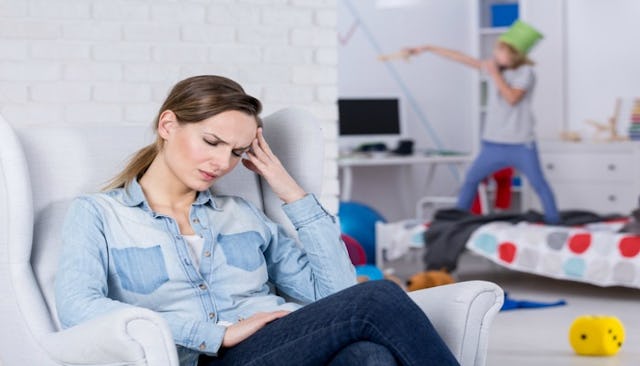Yes, Grown-Ass Women Can Have ADHD

My psychiatrist put down her pen. “I think you have ADD,” she said. “Do you have trouble with daily life skills most of your peers seem to manage fine?”
And I broke down weeping because I was so scared of money that I didn’t have a checking account; I couldn’t ballpark our mortgage payment; the water was always getting turned off because of a bill we overlooked. We had the money. I just forgot to pay it. Trash fell out of my car when I opened the doors, and I was always forgetting something — wipes, diaper bags, lunch.
I was 34, and I was finally being diagnosed with the disorder that had disrupted my entire life. I had the inattentive form of ADD (ADHD without the hyperactivity). And I’m not alone. A report shows that between 2008 and 2012, the use of ADHD meds of all stripes leapt a whole 85% in women 26 to 34. ADDitude Magazine reports that Patricia Quinn, MD, director of the National Center for Women and Girls with AD/HD, says that “the average age of diagnosis for women with ADHD, who weren’t diagnosed as children, is 36 to 38 years old.” Before that, she notes, women were “often misdiagnosed as having depression or an anxiety disorder. Even if these are secondary conditions, treating them does not get to the root of the problem, which is ADHD.”
Previously, many women went undiagnosed for several reasons. The DSM-IV required an onset of symptoms by age 7. These studies were based mostly on white boys, emphasized hyperactivity, and ignored what we now know: Many girls don’t manifest symptoms until they’re older. Now that the DSM-V has raised that age to 12, more women fall under the diagnostic criteria.
And people are becoming aware of how ADHD manifests itself, especially in adult women. It looks significantly different than it does in young white boys, who according to the Mayo Clinic, tend to be loud, fidgety, chattery, always on the go, interrupting people, turns, and games. Women, on the other hand, have trouble balancing their checkbook.
We often feel, according to the original list I found on ADDitude Magazine, that life is spiraling out of control. We’re afraid to have people over to our house because of the mess. We get overwhelmed, and the idea of “one more thing” can send us into a total tailspin. We often spend much of our time “coping, looking for things, catching up, or covering up.” People think we’re selfish because we don’t write birthday or thank-you cards.
I didn’t need to read the rest of the list then because I was crying. I remembered my wedding thank-yous. I put them off, and put them off. Then I forced myself to go to the stationery store. I bought 75 bucks worth of gorgeous cards. And over the course of one night, in a manic rush, I wrote all the notes, personalized, with little details about how we’d use the item or why it was meaningful to us. I put them in stamped, addressed envelopes.
Then I never fucking mailed them.
This was not your typical hyper little boy. ADHD looks different in girls, which is why we aren’t diagnosed, which is why my thank-you notes sat in my closet until our fifth anniversary. In an essay on ADHD and women, Quartz says that girls tend toward the inattentive version of the disorder — ADD, or ADHD without the hyperactivity. We have trouble with organization; we seem spacey. Frequently, we “mask it in an attempt to conform to society’s expectation that [we] be on the ball and organized.” We make careless mistakes. We daydream. We can often hide the social symptoms as well. But one study shows that girls with ADHD are “three to four times more likely to attempt suicide and two to three times more likely to report injuring themselves” than girls without ADHD.
And the risk doesn’t end in adolescence. According to the Anxiety and Depression Association of America, approximately 50% of adults with ADHD have an anxiety disorder. We’re also likely to have depression, bipolar disorder, or another psychiatric disorder. In many women, some of this may be the result of living with untreated ADHD for most of their lives. “I think we have a lost generation of women who are diagnosed with ADHD later in life, who have had to manage the condition on their own and deal with it on their own for the majority of their lives,” Michelle Frank, a clinical psychologist and ADHD expert, tells Quartz.
It’s no surprise, then, that as awareness increases, so do diagnoses among women. It can sometimes be a balancing act to find the right medication — one that doesn’t, for example, exacerbate an existing anxiety disorder. And it can feel, frankly, fake. I suffered from imposter syndrome for a full year after I was diagnosed; I couldn’t possibly have ADD. I was clearly faking it to cover up my own inadequacies. I still periodically feel that way — the remnant of a childhood of being told to “hurry up,” to “stop daydreaming,” of being asked, “What’s your problem?” and “Don’t you have any common sense?
But there’s hope — lots of it. If your symptoms match those ADDitude Magazine lists as specific to women, you need to make an appointment with your doctor. You don’t have to be the mom who always forgets the wipes anymore. Trash doesn’t have to fall out of your car when the door opens. And the clutter of children — the tiny shoes, the stuffed animals, the toys upon toys upon toys — doesn’t need to overwhelm you anymore. You can be the mom you were meant to be — without breaking yourself to do it.
This article was originally published on